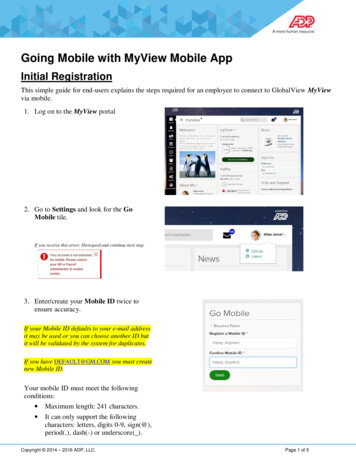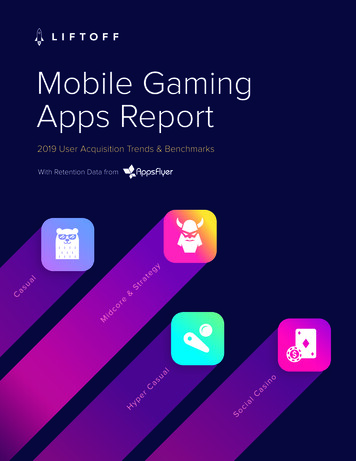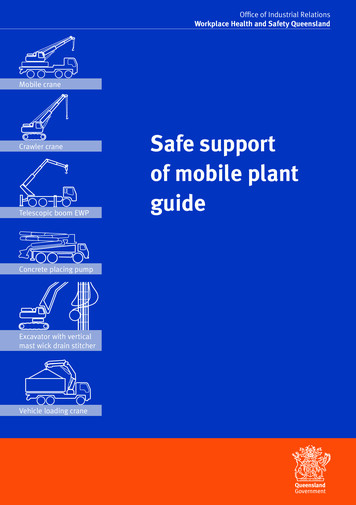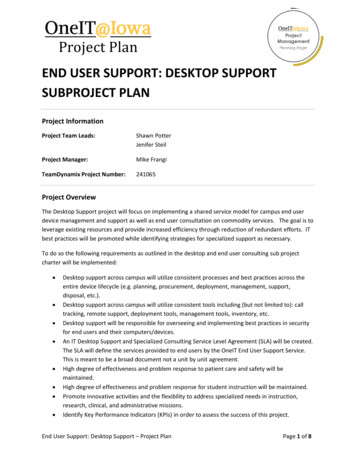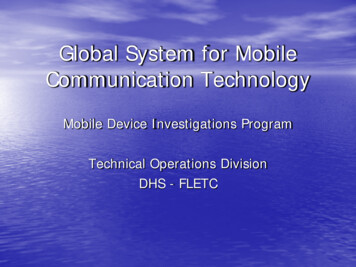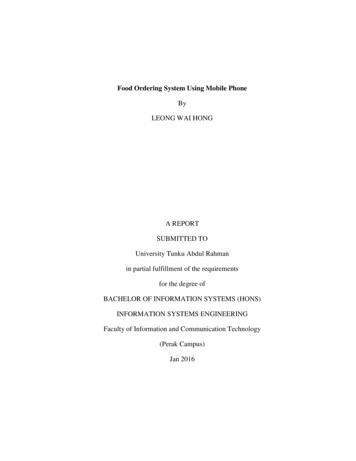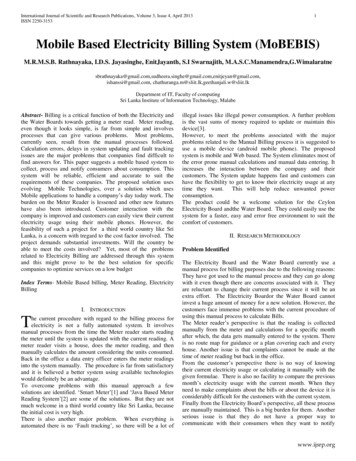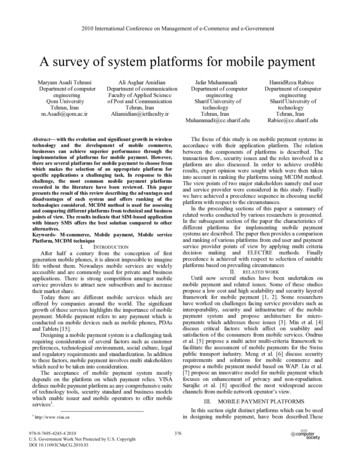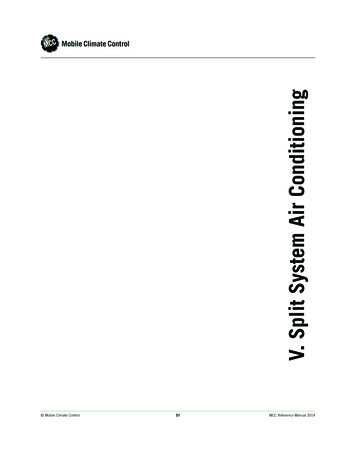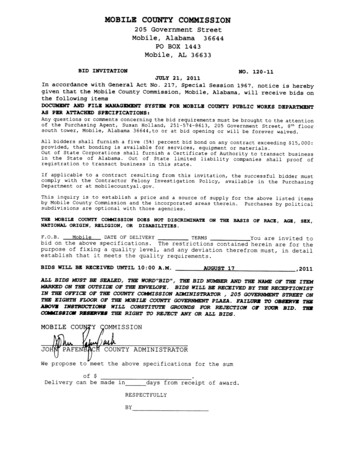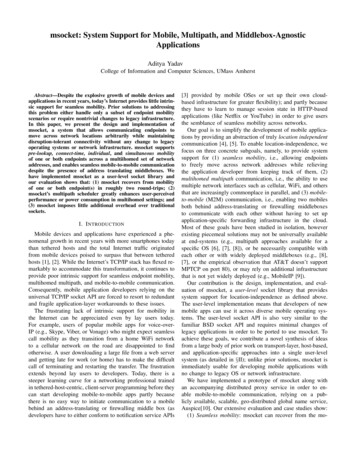
Transcription
msocket: System Support for Mobile, Multipath, and Middlebox-AgnosticApplicationsAditya YadavCollege of Information and Computer Sciences, UMass AmherstAbstract—Despite the explosive growth of mobile devices andapplications in recent years, today’s Internet provides little intrinsic support for seamless mobility. Prior solutions to addressingthis problem either handle only a subset of endpoint mobilityscenarios or require nontrivial changes to legacy infrastructure.In this paper, we present the design and implementation ofmsocket, a system that allows communicating endpoints tomove across network locations arbitrarily while maintainingdisruption-tolerant connectivity without any change to legacyoperating systems or network infrastructure. msocket supportspre-lookup, connect-time, individual, and simultaneous mobilityof one or both endpoints across a multiihomed set of networkaddresses, and enables seamless mobile-to-mobile communicationdespite the presence of address translating middleboxes. Wehave implemented msocket as a user-level socket library andour evaluation shows that: (1) msocket recovers from mobilityof one or both endpoint(s) in roughly two round-trips; (2)msocket’s multipath scheduler greatly enhances user-perceivedperformance or power consumption in multihomed settings; and(3) msocket imposes little additional overhead over traditionalsockets.I. I NTRODUCTIONMobile devices and applications have experienced a phenomenal growth in recent years with more smartphones todaythan tethered hosts and the total Internet traffic originatedfrom mobile devices poised to surpass that between tetheredhosts [1], [2]. While the Internet’s TCP/IP stack has flexed remarkably to accommodate this transformation, it continues toprovide poor intrinsic support for seamless endpoint mobility,multihomed multipath, and mobile-to-mobile communication.Consequently, mobile application developers relying on theuniversal TCP/IP socket API are forced to resort to redundantand fragile application-layer workarounds to these issues.The frustrating lack of intrinsic support for mobility inthe Internet can be appreciated even by lay users today.For example, users of popular mobile apps for voice-overIP (e.g., Skype, Viber, or Vonage) who might expect seamlesscall mobility as they transition from a home WiFi networkto a cellular network on the road are disappointed to findotherwise. A user downloading a large file from a web serverand getting late for work (or home) has to make the difficultcall of terminating and restarting the transfer. The frustrationextends beyond lay users to developers. Today, there is asteeper learning curve for a networking professional trainedin tethered-host-centric, client-server programming before theycan start developing mobile-to-mobile apps partly becausethere is no easy way to initiate communication to a mobilebehind an address-translating or firewalling middle box (asdevelopers have to either conform to notification service APIs[3] provided by mobile OSes or set up their own cloudbased infrastructure for greater flexibility); and partly becausethey have to learn to manage session state in HTTP-basedapplications (like Netflix or YouTube) in order to give usersthe semblance of seamless mobility across networks.Our goal is to simplify the development of mobile applications by providing an abstraction of truly location independentcommunication [4], [5]. To enable location-independence, wefocus on three concrete subgoals, namely, to provide systemsupport for (1) seamless mobility, i.e., allowing endpointsto freely move across network addresses while relievingthe application developer from keeping track of them, (2)multihomed multipath communication, i.e., the ability to usemultiple network interfaces such as cellular, WiFi, and othersthat are increasingly commonplace in parallel, and (3) mobileto-mobile (M2M) communication, i.e., enabling two mobilesboth behind address-translating or firewalling middleboxesto communicate with each other without having to set upapplication-specific forwarding infrastructure in the cloud.Most of these goals have been studied in isolation, howeverexisting piecemeal solutions may not be universally availableat end-systems (e.g., multipath approaches available for aspecific OS [6], [7], [8]), or be necessarily compatible witheach other or with widely deployed middleboxes (e.g., [8],[7], or the empirical observation that AT&T doesn’t supportMPTCP on port 80), or may rely on additional infrastructurethat is not yet widely deployed (e.g., MobileIP [9]).Our contribution is the design, implementation, and evaluation of msocket, a user-level socket library that providessystem support for location-independence as defined above.The user-level implementation means that developers of newmobile apps can use it across diverse mobile operating systems. The user-level socket API is also very similar to thefamiliar BSD socket API and requires minimal changes oflegacy applications in order to be ported to use msocket. Toachieve these goals, we contribute a novel synthesis of ideasfrom a large body of prior work on transport-layer, host-based,and application-specific approaches into a single user-levelsystem (as detailed in §II); unlike prior solutions, msocket isimmediately usable for developing mobile applications withno change to legacy OS or network infrastructure.We have implemented a prototype of msocket along withan accompanying distributed proxy service in order to enable mobile-to-mobile communication, relying on a publicly available, scalable, geo-distributed global name service,Auspice[10]. Our extensive evaluation and case studies show:(1) Seamless mobility: msocket can recover from the mo-
II. BACKGROUND AND RELATED WORKmsocket draws upon a large body of prior work on enablingintrinsic support for seamless mobility. To our knowledge,msocket is the first immediately usable system to support allfour types of endpoint mobility; msocket is also the first tooffer an application-agnostic solution for bidirectional communication initiation despite the presence of address-translatingmiddleboxes. Below, we explain how msocket’s underlyingtechniques compare to closely related prior work.Architectural alternatives. Existing approaches to handle mobility, i.e., an endpoint identifier changing networklocation(s), can be broadly classified into three categories:(1) indirection, (2) global name resolution, (3) name-basedrouting. Indirection approaches, e.g., MobileIP [9], LISP[11],i3[12], ROAM[13], GSM[14], route to a fixed network address, the home address, and a home agent router tunnelsall data packets to the mobile’s current location. Indirectionschemes enable seamless mobility of one or both endpointsat any time and are oblivious to non-mobile endpoints.However, as a consequence, they have to indirectly routeall data through the home agent exacerbating path inflation;direct routing extensions can address the triangle routingproblem but mobility of an endpoint is no longer oblivious tothe other endpoint. Global-name-resolution-based approaches,e.g., HIP[8], LNA[15], MobilityFirst[16], XIA[17] rely ona logically centralized global name service (e.g., DNS orAuspice[10]) that resolves an endpoint identifier to its networklocation(s). This approach requires a lookup to the nameservice at connection initiation time and in order to handlesimultaneous (but not individual) mid-session mobility, anddoes not suffer from data path inflation. Pure name-basedrouting approaches, e.g., ROFL[18], TRIAD[19], NDN[20],eschew network locators and route directly on flat or structurednames, which in theory allows any mobility to be completelyseamless to endpoints, but in practice can induce outage timescommensurate to convergence delays for network routingunless they additionally rely on indirection or global nameresolution.As an important goal of our work is immediate deployability, we restrict our discussion in the rest of this section torelated approaches that are interoperable with today’s TCP/IPInternet and, in particular, do not require significant changesto network routers or middleboxes.Global name serviceA, IP0 Time-to-connectTimeoutbility of one or both endpoints; the client- and server-initiatedrecovery complete in 2 and 2.5 RTTs respectively.(2) Multihomed multipath: msocket’s multipath schedulerimproves the single-best path’s performance by up to 1.5 inWiFi cellular settings similar to in-kernel MPTCP’s uncoupled mode despite having no access to internal TCP state.(3) Mobile-to-mobile: Our case studies using an Androidphone show that msocket enables applications to employseamlessly mobile or “roaming” servers in a manner agnosticto address-translating middleboxes.More broadly, we hope that msocket has a pedagogical valuethat may further spur longer-term innovation. A student beingintroduced to network programming in a first course on networking will be immediately able to field their general-purposenetwork programs as-is in new and interesting mobile-tomobile settings by using msocket instead of traditional sockets.Whether or to what extent this ability fosters innovation, onlytime will tell; msocket is but a first step towards that goal.The rest of this paper is organized as follows. §III describes the detailed design and implementation of msocket.§IV presents a comprehensive evaluation of msocket’s performance, cost, and functionality using case study scenarios, and§V concludes. We begin with a delineation of msocket’s goalsand design from a large body of closely related work. IP2connect(B, IP2 )B,) IP22) ConnectmobilityB, IP3XBIP3connect(B, IP3 )Connection Established A, IP6B, IP2BB, IP1)1) Pre-lookupmobilityConnection re-synchronizedBB, IP5)3) IndividualmobilityB, IP4)4) SimultaneousmobilityB, IP5IP5connect(B, IP5 )Connection re-synchronizedFig. 1: Four types of endpoint mobility events.Types of mobility events. Figure 1 shows how a globalname service can enable quick recovery from four types ofmobility events, a classification recently proposed by Sharmaet al [10]. These four types of mobility could be a commoncase scenario when two mobile phones, as a server and aclient, are communicating and switching between cellular andWiFi or switching WiFi APs. Today’s DNS-based Internetis designed to support only pre-connect mobility at coarsetimescales. Table I shows whether and how several priorproposals handle the remaining mobility events, as we alsoexplain in detail below.Connect-time mobility: A connect(server name)request issued by a client can fail because the server endpointmay have changed its network address after the client queriedthe name resolution service but before a three-way handshakecompleted. Addressing this scenario requires (1) a highlyscalable global name service that can quickly register andreturn the fresh location of the server, and (2) a tight couplingbetween the connect request and the name service. msocketrecovers from connect-time mobility by re-querying the Auspice global name service [10] and retransmitting connectionrequests. In contrast, the traditional socket API and mosthost-based approaches relying on DNS do not support rapidrecovery from connect-time mobility and incur an outage timecommensurate to DNS’s long update propagation delays.Individual mobility. Transport-layer approaches such asECCP[7], MPTCP[6], TCP-Migrate[21] use different approaches to handle individual endpoint mobility, i.e., when one(but not both) endpoint moves at a time, the most well-studied
oyesnoM2MyesnononononoInfrastructure changesappapp,app,app,app,app,kernel, middleboxkernelkernelkernelkernel, routerTABLE I: Comparison of approaches for connection mobility, multipath, and middlebox-agnostic (M2M) communication.mobility case. All of these recover from individual mobilityin a bilateral manner (without re-querying the name service).TCP-Migrate and its precursor TCP-R[22] were early effortsthat pioneered the case for handling individual connectionmobility in a bilateral manner, but they implicitly assumeda single-path TCP connection equating a connection endpointto a singly-homed host. HIP, a host-based approach, supportsmultiple paths but equates a path with an interface. In contrast,msocket, like ECCP and MPTCP, enables a flexible, many-toone mapping between flowpaths and network interfaces.Server mobility, a special case of individual mobility, isharder to handle than client mobility as it requires either (a)the client to time out and re-query the global name service, or(b) the server to proactively notify the client at its old address,thereby implicitly requiring a listening “server” at the client.Simultaneous mobility. Several prior transport approaches,e.g., TCP-Migrate, MPTCP, consider simultaneous mobility,when an endpoint loses its current address during the time theother endpoint is changing its address, to be a rare case, suggesting that they could fall back on a DNS-like external infrastructure to handle this case. However, simultaneous mobilitymay not be that uncommon in disconnection-tolerant mobileapplication scenarios, e.g., when a mobile user switches offher smartphone while on the road and resumes watchinga movie using WiFi at home, by which time the virtualmachine hosting the Flash server may have been migrated forload balancing purposes. HIP explicitly designates rendezvouspoints in the architecture to handle this case, wherein thehost identifiers can be used to securely resynchronize theconnection. ECCP alludes to the possibility of handling thiscase using a lightweight, network-layer router cache in eitherendpoint’s subnet that briefly re-routes data packets (similarin spirit to Mobile IP that seamlessly handles simultaneousmobility using home agents), however their approach worksonly if at least one path, the “control channel”, between theendpoints remains unbroken.Multipath data transfer. MPTCP supports multipathscheduling but as it is a kernel based approach and changesthe TCP headers, it is not supported by all the middleboxes,as acknowledged in [6]. msocket uses the legacy TCP connections and implements multipath scheduling in the applicationlayer. All the multipath connection establishment and datapacket headers are sent as data payload in TCP, so a msocket’smultipath connection is never dropped by middleboxes. Ourevaluations show that msocket achieves performance close toMPTCP, even after being implemented in the application layer.Middlebox-agnostic M2M communication. None of thetransport- or host-centered approaches above are designed toenable mobile-to-mobile communication when both mobilesare behind address-translating or unidirectionally firewallingmiddleboxes. msocket’s approach relies on an external proxyservice that is similar in spirit to application-specific approaches (e.g., Skype) but differs in that it provides anapplication-agnostic socket API usable by any application.Infrastructure changes. All host-centered approaches toenable mobile and/or multihomed multipath communicationrequire some modification to legacy applications in order forthem to fruitfully leverage non-default policies to decide whento migrate an existing flowpath or how to stripe data acrossmultiple interfaces. In this respect, msocket is comparable asits API is very similar to the BSD socket API with supportfor reasonable default policies for migration and multipath, andnew calls are required only to leverage non-default policies.msocket’s strength is that it does not require any change todiverse OS kernels, middleboxes, or routers.Name service. Our envisioned approach to handle endpointmobility implicitly assumes a massively scalable global nameservice (Figure 1) that can rapidly register updates and returnfresh responses to lookups. DNS with its heavy reliance onlong-lived TTLs, and designed in an era when mobility washardly the norm, is not well suited to this kind of usage.Therefore, msocket relies on Auspice [10], an open scalable,geo-distributed global name service that also shares our highlevel goal of recovering from arbitrary endpoint mobility inan agile manner. However, the Auspice work focuses onlyon the design of a distributed name service and leaves as anopen issue the design of an endpoint stack to achieve locationindependence–a gap that we fill with msocket in this paper.III. MSOCKET DESIGN AND IMPLEMENTIONIn this section, we describe the design of msocket that consists of the following three functional components: (1) seamless connection mobility, (2) multihomed multipath scheduling, and (3) middlebox-agnostic mobile-to-mobile communication. Clean support for the first greatly simplifies the designof the latter two components as well, so we begin by describinghow msocket enables connection mobility.A. Design overviewAt a high-level, msocket enables a location-independentcommunication abstraction that allows endpoints to connect to and communicate with fixed names without worrying about their changing network locations (or IP addresses). Thus, msocket allows a client to invoke a method
connect(server name) (like most high-level networkprogramming languages do today) and additionally rest assured that, even though the IP address(es) of both endpointsmay change arbitrarily, reliable byte-stream communicationwill resume gracefully during periods when at least onenetwork path exists between the two endpoints.A msocket is bound to a two-tuple [client name,server name] that remains unchanged throughout its lifetimeuntil it is explicitly closed by one of the endpoints. Underneath, msocket maintains zero or more active flowpaths,wherein each flowpath is bound to a pair of [IP, port] tuplesrespectively belonging to each endpoint. As msocket is a userlevel socket library, each flowpath is naturally well servedby an underlying traditional TCP/IP connection that is boundto a pair of IP addresses (and ports) that are unchangeableby design. However, connection mobility poses a challenge,especially when exactly one flowpath exists between thetwo endpoints and one of the endpoints ungracefully (orunexpectedly) changes its address, as that requires msocketto migrate from the old, unusable flowpath to a new onewhile maintaining a reliable byte-stream abstraction from theapplication’s perspective.Ensuring correctness of the reliable transfer requires resynchronizing sequence numbers over the new flowpath so thatan endpoint can ascertain the exact number of bytes correctlyreceived by the other endpoint over the old flowpath. However,sequence numbers in the underlying connection are by designnot visible from the user level, i.e., an application (or for thatmatter the kernel) can not determine exactly how many of theoutstanding bytes have been received by the other endpointat any point in time; moreover, an application has no wayto explicitly specify the initial sequence number of the bytestream over the new flowpath’s underlying connection.msocket addresses this problem by maintaining separatesequence numbers and buffers in a user-level structure thatenwraps the underlying sockets. A msocket comprises of:(1) flowpath socket(s) that refer to one or more underlyingsockets for exchanging data; (2) output and input buffers thatare user-level buffers maintained by msocket respectively forretransmission at the sender and to handle reordering at thereceiver; (3) connectionless control socket, a single underlyingconnectionless socket used primarily as a connectionless serverat an msocket client in order to handle server mobility. Weexplain msocket’s connection management in detail next.B. msocket connection managementAn msocket connection consists of four phases: (1) establishment, (2) data tran
IP (e.g., Skype, Viber, or Vonage) who might expect seamless call mobility as they transition from a home WiFi network to a cellular network on the road are disappointed to find otherwise. A user downloading a large file from a web server and getting late for work (or home) has to mak

